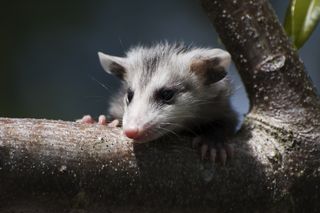Facts About the Common Opossum

There are more than 60 species of opossum. The species that many people think of when hearing about this animal is the common opossum, also known as Virginia opossum. However, these are two different species. The common opossum's scientific name is Didelphis marsupialis, and the Virginia opossum's scientific name is Didelphis virginiana.
These types of opossums have a cone-shaped nose with a pink tip, a long hairless tail, and white, gray and black fur. Opossums are the only marsupial found naturally in North America.
Size
Opossums are about the size of small dogs. They are about 2.5 feet (76 centimeters), nose to tail, and weigh 8.8 to 13.2 lbs. (4 to 6 kilograms), according to National Geographic.
Habitat
The common opossum and Virginia opossum are found in the United States, Mexico, Central America, South America and Canada. Though they aren't picky about where they hang out, opossums love trees and will stay aloft in trees as much as possible. They also prefer areas that are wet, like marshes, swamps and streams.
Habits
Opossums are nocturnal, which means they are awake at night and sleep during the day. They spend nights searching for food.
Though they don't hibernate, opossums do slow down during the winter. They live in burrows that they fill with dry leaves or even shredded paper, and fat reserves help keep them warm. In the summer, they will lick themselves and cover their fur in spit to keep cool, according to the Animal Diversity Web.
Diet
Opossums are known for scavenging though trash. They are omnivores, which means they eat both vegetation and meat, and they aren't picky. In the wild, they will munch on nuts, grass and fruit. They will also hunt insects, mice, wild birds, snakes, worms and chickens. In the city they will eat roadkill and garbage.
Offspring
Males have forked penises. It was once thought that the reason for this physical feature was that they bred with the female's nose. It was thought that once the babies were born, the mother would sneeze the babies into her pouch. This isn't true. These marsupials breed much like other mammals.
Opossums reproduce twice a year. Once mating is done, the male, called a jack, leaves and doesn't return. After a gestation of just 12 to 13 days, female opossums, called jills, give birth to up to 20 live young at a time.
The babies, called joeys, are about the size of jelly beans when they are born. They immediately crawl into the mother's pouch to continue developing. Even as the joeys grow older, the mother will still carry them on her back wherever she goes. They will stay with their mother for about 100 days. Typically, most of the joeys don't survive. Joeys become sexually mature at six to eight months and live for one to two years.
Classification/taxonomy
Here is the taxonomy of the common opossum, according to the Integrated Taxonomic Information System:
Kingdom: Animalia Subkingdom: Bilateria Infrakingdom: Deuterostomia Phylum: Chordata Subphylum: Vertebrata Infraphylum: Gnathostomata Superclass: Tetrapoda Class: Mammalia Subclass: Theria Infraclass: Metatheria Order: Didelphimorphia Family: Didelphidae Subfamily: Didelphinae Genus: Didelphis Species: Didelphis marsupialis Subspecies: Didelphis marsupialis caucae, Didelphis marsupialis marsupialis
Conservation status
While some opossums are endangered or extinct, the common opossum is listed as least concern by the International Union for Conservation of Nature (IUCN). Its population is listed as stable.
Other facts
Opossums really do play dead. They will flop down and be very still with their tongue hanging out to trick predators. Sometimes this trick will allow opossums to escape. Playing dead can last up to six hours, according to ADW.
Like other marsupials, opossums have thumbs, called an opposable hallux, on their paws. These thumbs are on the back feet as well as on the front feet. Their tails are prehensile and can be used to help them climb and hold onto tree branches.
Though opossums will hiss at humans, they are rarely aggressive, according to The Humane Society.
Opossums are immune to snake bites, bee stings and other toxins, according to the National Wildlife Federation.
Additional resources
Sign up for the Live Science daily newsletter now
Get the world’s most fascinating discoveries delivered straight to your inbox.
